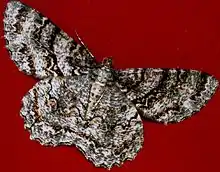Epimecis hortaria
Epimecis hortaria, the tulip-tree beauty, is a moth species of the Ennominae subfamily found in North America. It is found throughout New England south to Florida and west to Texas and Missouri. It was first described by Johan Christian Fabricius in 1794.[2] It can be seen flying from late March to early October. Adults are nocturnal and attracted to lights.[3] The immature caterpillars can be found feeding on Magnolia, Asimina, Populus, Sassafras and Liriodendron.[4]
| Tulip-tree beauty | |
|---|---|
 | |
| Scientific classification | |
| Kingdom: | |
| Phylum: | |
| Class: | |
| Order: | |
| Family: | |
| Genus: | |
| Species: | E. hortaria |
| Binomial name | |
| Epimecis hortaria | |
Identification
With a wingspan of 43–55 mm, E. hortaria is one of the larger geometer moths.[5] There are two forms, one being "Dendraria" and the other being "Carbonaria". The Dendraria has a broader median with subterminal lines while the Carbonaria is darker with white edging.[3] The thick bodied caterpillar has a swollen 3rd thoracic segment. The caterpillar is gray to brown with darker markings, faint pinstripes and orange spiracles.[2]
References
- "Epimecis hortaria Fabricius 1794". Encyclopedia of Life. Retrieved 2009-12-16.
- Evans, Arthur V. (2007). Field Guide to Insects and Spiders of North America. Sterling Publishing Co., Inc. p. 320. ISBN 978-1-4027-4153-1.
- "Species Epimecis hortaria – Tulip-tree Beauty – Hodges#6599". BugGuide. Retrieved 2009-12-16.
- "Epimecis hortaria". Retrieved 2009-12-16.
- "Species Detail Butterflies and Moths of North America". Archived from the original on 2012-07-20. Retrieved 2009-12-16.